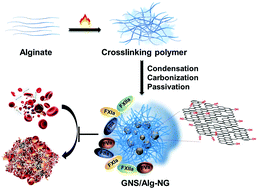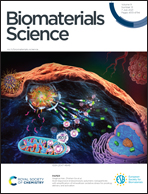Thermally driven formation of polyphenolic carbonized nanogels with high anticoagulant activity from polysaccharides†
Abstract
We have demonstrated that alginate with negligible anticoagulant activity can be converted into carbonized nanogels with potent anticoagulant activity through a solid-state heating process. The conversion of alginate into graphene-like nanosheet (GNS)-embedded polyphenolic-alginate nanogels (GNS/Alg-NGs) has been carried out through condensation and carbonization processes. The GNS/Alg-NGs exhibit much stronger anticoagulant activity (>520-fold) compared to untreated alginate, mainly because their polyphenolic structures have a high binding affinity [dissociation constant (Kd) = 2.1 × 10−10 M] toward thrombin. In addition, the thrombin clotting time delay caused by the GNS/Alg-NGs is 10-fold longer than that of natural polyphenolic compounds, such as quercetin, catechin, naringenin, caffeic acid, and ferulic acid. The thrombin- or kaolin-activated thromboelastography of whole-blood coagulation reveals that the GNS/Alg-NGs display a much stronger anticoagulant ability than that of untreated alginate and naturally sulfated polysaccharides (fucoidan). The GNS/Alg-NGs exhibit superior biocompatibility and anticoagulant activity, as observed with an in vivo rat model, revealing their potential as a blood thinner for the treatment of thrombotic disorders.



 Please wait while we load your content...
Please wait while we load your content...